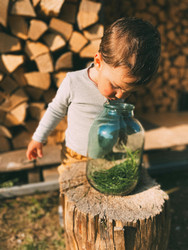Outdoor Learning in All Seasons: Embracing Natures Classroom
Posted by AIR Training Solutions on Oct 30th 2024
Outdoor learning offers children a unique opportunity to engage with their environment in a hands-on, dynamic way. Regardless of the season, outdoor learning provides numerous benefits that contribute to children's physical, mental, and emotional development.
Benefits of Outdoor Learning:
Engaging in outdoor activities allows children to develop an appreciation for nature, fostering a sense of wonder and curiosity about the world around them. Studies have shown that outdoor learning can enhance cognitive abilities, improve concentration, and reduce stress and anxiety. Additionally, exposure to natural light and fresh air can contribute to overall health and well-being.
Outdoor Activities for Children:
Toddlers, preschoolers, and school-age children can all benefit from outdoor activities that are tailored to their age and developmental stage. For toddlers, activities such as nature walks, sensory exploration, and simple games like "I Spy" can provide valuable learning experiences. Preschoolers can engage in activities such as nature scavenger hunts, gardening, and outdoor art projects. School-age children can participate in more complex activities like birdwatching, nature journaling, and science experiments in outdoor settings.
Outdoor Activities by Season:
Spring:
As the temperatures start to rise and nature comes back to life, spring provides an excellent opportunity for outdoor learning. Activities such as bird watching, identifying different plant species, and studying the life cycles of insects are educational and engaging for all ages. Spring is also an ideal time for gardening activities, allowing students to learn about plant growth and sustainability.
Summer:
During the warmer months, outdoor learning can involve activities such as nature hikes, camping, and stargazing. This season offers the chance to explore ecosystems, conduct water experiments, and study the behavior of various living organisms. Summer also presents an excellent opportunity for outdoor art and craft projects inspired by nature and natural elements.
Fall:
The changing colors of the leaves, the migration of birds, and the harvesting of crops make fall an exciting time for outdoor exploration. Activities such as leaf identification, studying animal behavior as they prepare for winter, and learning about the changes in the natural environment can provide valuable learning experiences. Additionally, fall is a great time for students to learn about sustainability and conservation efforts.
Winter:
Even in the colder months, outdoor learning can be both enjoyable and educational. Winter activities may include studying animal tracks in the snow, conducting experiments related to weather and temperature, and learning about the adaptations of plants and animals to survive the winter season. Winter also offers a great opportunity for students to learn about the significance of weather patterns and climate change.
Example Lesson Plan for Preschoolers:
Title: Exploring Insects in the Garden
Objective: To introduce preschoolers to basic concepts about insects and their role in the ecosystem.
- Start with a nature walk to observe insects in their natural habitat.
- Discuss different types of insects and their characteristics.
- Engage in a bug hunt in the garden, using magnifying glasses to observe insects up close.
- Encourage children to draw or describe the insects they encounter.
- Conclude with a group discussion about the importance of insects in the environment.
By embracing outdoor learning in all seasons, educators and parents can provide children with valuable opportunities for growth, exploration, and discovery. The benefits of outdoor learning are manifold, and the experiences gained can provide a foundation for a lifelong connection to the natural world.

